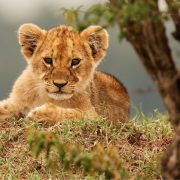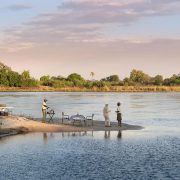As one of the world’s greatest natural spectacles, it is no wonder the annual Great Migration, also known as the wildebeest migration, is on the top of everyone’s African travel bucket list.
And although the most commonly shared footage is that of the famed river crossings, there is so much more to a migration safari in East Africa.
Here’s our guide to the great migration: how it works, when to go and what to expect.
What is the Great Migration?
The annual migration sees some 1.4 million wildebeest and a few hundred thousand zebra travel through Tanzania’s vast Serengeti National Park into the famed Masai Mara National Reserve just over the border in Kenya in search of new grazing. It is an arduous journey, with many falling by the wayside – commonly nabbed by stealthy lion prides in the savannah regions and by hungry crocodiles that line the banks of the Grumeti and Mara Rivers.
The search for lush grazing and water is prescribed by the seasons, which makes following the herds across the parks always slightly different year on year. Because the herds move in a circular pattern, there is no endpoint; it’s about knowing where to be when they are passing through.

Our Month to Month Guide
November – December
The herds, of wildebeest and zebra, move southwards into the southern Serengeti, where the arrival of the short rains sees a lush growth in the grassy plains. The herds start moving slowly towards the south-western part of the park, with plenty of lion, hyena and cheetah in their wake.

December – March
The babies arrive! Calving season is a popular time to visit the Serengeti, as the vast southern plains in the Ndutu area are filled with huge herds of wildebeest, gazelle and zebra. Due to the rains, the area is naturally quite wet, which is why this period is also commonly referred to as ‘The Green Season’ – a time of natural abundance.

April – June
The long march begins northwards in the hunt for more grazing, as the herds make their way from Ndutu through to the Seronera area and finally towards the Grumeti. This is a wonderful time for photography, as the plains are lit by a magical light that comes from the intermittent rainstorms that begin properly in April. This is a popular time to visit.

June
The herds continue moving through the Western Corridor of the Serengeti, ever further north towards the Grumeti River. By this time, the rains have slowed, which means driving around is a little easier. As this part of the park is well noted for its abundant plains game and predators, it’s a great spot to visit in June for an overall game viewing experience.

July
The scenic northern region includes the famous Lobo Valley kopjes, little hills that jut out of the sweeping plains, providing an attractive backdrop to the thrills that await. The Grumeti and Mara rivers lie in wait, swollen from the long rains. The animals start amassing on the banks, and it’s anyone’s guess as to when the crossings will start…

July, August and September
From late July, the herds swarm over the Grumeti and Mara rivers to reach the more abundant grazing lands of the Masai Mara National Reserve over the border in Kenya. This is the pinnacle of the migration experience for many visitors and booking well in advance will secure your spot in a camp close to all the action. However, due to the seasonality of the rains, the herds sometimes arrive early or late for the crossings, so it’s best to stay for a few days for the best chance in seeing the drama unfold.

October – November
The animals have now moved into lush grazing in the Masai Mara. Here they will stay for some time before moving back down south into the Serengeti. The game-viewing is exceptional during this time; predators roam the plains, taking advantage of the abundance, and the variety of animals is added to by endemic species.

Keep in Mind
There are a few things to keep in mind when planning your great wildebeest migration safari to East Africa:
- Rainfall – this directly relates to when the animals move from region to region in the search for newly grown grass to graze. Chat to your travel planner about the year’s seasonality and weather patterns in order to make an educated decision about when to travel.
- Mobility – there are many camps that move with the animals on a seasonal basis, ensuring you’re closer to the herds in that particular year. These mobile camps offer a slightly more down-to-the-ground experience, but are fully serviced. If you choose a permanent camp or lodge, you may need to travel further during the day to get to where the herds are.

- Tanzania or Kenya – consider which time of the year you want to go. Most of the year the animals are based in the Serengeti, with a shorter overall stay in the Masai Mara. However, you can also combine your Kenya migration experience with additional wildlife encounters in the Mara, or other popular parks like the Samburu, Tsavo or Amboseli.
- River Crossings – this is tricky, as each year the timing of this differs. However, late July through August is when you can generally expect the crossings – and would also be a good time to be in the Mara to see the herds start to amass there.
- Combination safaris – you can easily combine a multitude of East Africa wildlife experiences to make the most of your visit:
- Safari and beach – combining the Serengeti with Zanzibar, or the Masai Mara with Lamu.
- Big game encounters – a visit to the Ngorongoro Crater is a must! Almost every animal can be found in a relatively small area, so the richness in game viewing is incredible.
- Cultural trip – visit local Samburu or Maasai villages on your trip, or consider combining your migration safari with a Me to We experience, giving back to local communities.
- Off the beaten track – once you’ve completed the migration portion of your safari, consider visiting some further-flung destinations: the Mahale Mountains and Katavi National Parks in Tanzania, Meru National Park and Shaba National Reserve in Kenya.
- Best of the best – Amboseli in Kenya offers superb big game sightings plus views of Mount Kilimanjaro, while tracking mountain gorillas over the Rwandan border in the Volcanoes National Park is unforgettable.

Without a doubt, a trip to see the Great Migration is a bucket-list African safari experience. If you’re thinking about a migration safari, contact one of our experienced Travel Planners, and we’ll start planning the perfect migration safari package to suit your budget and requirements.













